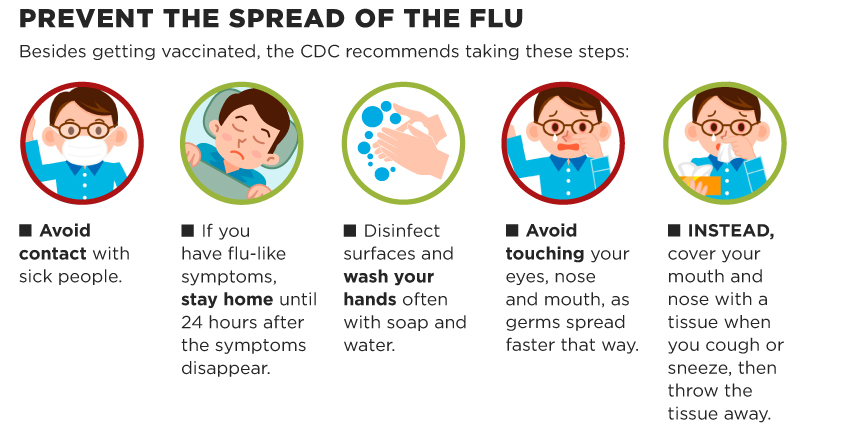
Brookelynn Drake, 7 months, cries after getting a flu shot at Southern Nevada Health District, 330 S. Valley View Blvd., on Monday, Jan. 14, 2013.
Monday, Jan. 19, 2015 | 1:59 a.m.
Flu season has arrived, and this year is expected to be one of the worst in recent memory. Health officials say this year’s flu vaccine is, at best, only 23 percent effective. Typically, flu shots reduce a person’s chance of getting sick by about 60 percent. H3N2, the most potent strain of flu virus this year, morphed after the vaccine was developed, rendering it largely ineffective. Flu season most commonly peaks between December and February. Here’s a look at how the virus spreads, how vaccines are formulated and how you can keep healthy.
Influenza, like Ebola or the measles, is a viral disease. Viruses lurk in our environment, waiting for an appropriate host. They can enter the body through the nose, mouth or cuts. Once inside, they begin what’s called the lytic cycle to replicate and infect the carrier.
HOW THE FLU MAKES YOU SICK
1. A sick person sneezes or coughs.
2. You inhale a virus particle, and it attaches to cells lining the sinuses in your nose.
3. The virus attacks the cells and rapidly reproduces new viruses.
4. The new viruses spread into your bloodstream and lungs. Because you have lost cells lining your sinuses, fluid flows into your nasal passages and gives you a runny nose.
5. Viruses in the fluid drip down your throat and attack the cells lining your throat, causing a sore throat.
6. Viruses in your bloodstream attack muscle cells and cause you to have muscle aches.
Source: HowStuffWorks
HOW VIRUSES REPLICATE
1. The virus enters the body.
2. The virus particle attaches to a host cell and bores a hole into its membrane.
3. The particle releases its genome, or genetic instructions, into the host cell.
4. The genome replicates by recruiting the host cell’s enzymes to make parts for new virus particles.
5. The parts assemble themselves into new virus particles.
6. The new particles break free from the host cell and can attack other cells.
CHOOSING WHICH STRAINS TO FIGHT
There are three types of flu: Influenzavirus A, B and C. Together, the categories encompass about 300 individual flu strains.
Humans can contract all three types. Influenzavirus A contains the worst viruses, including H1N1, also known as swine flu, and H5N1, or bird flu.
Twice a year, the World Health Organization reviews influenza cases worldwide and decides which strains should receive priority for vaccination. Laboratories around the world send common flu viruses to five research labs overseen by the World Health Organization, including the Centers for Disease Control in Atlanta.
In February of each year, the World Health Organization reviews the findings of the five laboratories to determine which strains should be included in seasonal vaccines.
In the United States, a U.S. Food and Drug Administration committee reviews the recommendations and makes a final decision regarding all the vaccines that will be produced in the country.

DON'T FALL FOR THESE COMMON FLU MYTHS
The flu is a more severe version of the common cold.
FALSE
While influenza has many of the same symptoms as a cold, it’s a different illness and much more dangerous. People with weakened immune systems, including the elderly, infirm and young, are particularly vulnerable.
You don’t need to get vaccinated every year.
FALSE
Yes, you do, because the flu virus constantly mutates. This is called antigenic drift; mutations add up over time to make existing antibodies ineffective at destroying a virus. Every year, public health officials decide which strains to include in vaccines, meaning the vaccine you got last year may not be the same vaccine you receive this year.
Getting two vaccinations increases immunity.
FALSE
Researchers have found no added benefit to getting vaccinated twice, although some children between the ages of 6 months and 8 years need two doses a month apart.
The flu vaccine, or other vaccines, causes autism.
FALSE
Thiomersal, a mercury-based preservative used in many vaccines, is believed by some to cause autism in children. But extensive medical research has failed to find such a connection. Despite the science, public distrust has caused many to avoid vaccines, fueling a resurgence of preventable diseases. One researcher called the trend “the most damaging medical hoax of the last 100 years.”
You can get the flu from a flu shot.
FALSE
The virus in a flu shot is inactive. If you get the flu right after you get a vaccine, you got it because you were exposed to the virus before your body built up enough antibodies, which usually takes about two weeks.
MODERN HISTORY OF THE FLU
1889: A flu pandemic started in Russia and spread across the entire northern hemisphere in a matter of months. Close to 1 million people died.
1918: The worst flu pandemic in modern history took hold during World War I in Europe, lasting two years. Because of advances in travel, H1N1 Spanish Flu spread quickly across the globe, killing tens of millions of people. It is regarded as one of the worst medical disasters in history.
1938: Jonas Salk and Thomas Francis developed the first flu vaccine. It was distributed widely among U.S. military troops during World War II.
1957: Asian flu killed about 1 million people in China and tens of thousands in the United States.
1968: A mutated H3N2 version of Asian flu killed 1 million people worldwide.
1997: Scientists discovered the first flu virus transmitted from birds to humans. Eighteen people were hospitalized in Hong Kong after contracting H5N1 bird flu from poultry markets. Six died.
2009: Swine Flu, the most recent H1N1 pandemic since Spanish Flu, spread around the world and killed about 20,000. It had the lowest mortality rate of any previous pandemic but was widely reported in the media and declared an international public health emergency by the WHO.
2013: Quadrivalent vaccines were introduced, protecting against four flu strains, one more than the widely used trivalent vaccine.
2013: The first recombinant vaccine was put into use. Made from insect-cell cultures, these trivalent vaccines contain no preservatives, eggs or live flu.

Join the Discussion:
Check this out for a full explanation of our conversion to the LiveFyre commenting system and instructions on how to sign up for an account.
Full comments policy